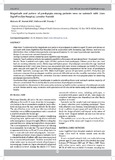| dc.contributor.author | Kariuki, Millicent M | |
| dc.date.accessioned | 2013-05-25T06:30:38Z | |
| dc.date.available | 2013-05-25T06:30:38Z | |
| dc.date.issued | 2012-07 | |
| dc.identifier.citation | Magnitude and pattern of presbyopia among patients seen on outreach with Lions SightFirst Eye Hospital, Loresho- Nairobi, Mukuria M, Kariuki MM, Kollmann Trivedy M. J. , East African Journal of Ophthalmology, (2012) copy at http://profiles.uonbi.ac.ke/millicentkariuki/publications/magnitude-and-pattern-presbyopia-among-patients-seen-outreach-lions-si | en |
| dc.identifier.uri | http://erepository.uonbi.ac.ke:8080/xmlui/handle/11295/25530 | |
| dc.description.abstract | Objectives:
To determine the magnitude and pattern of presbyopia in patients aged 35 years and above on
outreach with Lions SightFirst Eye Hospital and its association with increasing age, literacy level and sex
distribution; Also to determine spectacle coverage and reasons for not wearing presbyopic spectacles.
Design:
Cross sectional outreach based study.
Setting:
Outreach centres visited by Lions SightFirst Eye Hospital.
Subjects:
Four hundred and forty two patients aged thirty-five years old and above from 13 outreach centres.
Results:
Three hundred and eighty eight (87.8%) patients had presbyopia. Fifteen point four per cent
had pre-existing refractive errors. Males required higher power of presbyopic correction for age matched
individuals (p=0.001) and lower literacy was associated with more severe presbyopia (p=0.004). Forty four
point two per cent aged 35 to 39 years had presbyopia. Females experienced earlier onset of presbyopia
(p=0.008). Spectacle coverage was 33%. Males had higher uptake of spectacles (p=0.01). Forty four per
cent were unaware their presbyopia could be corrected, 39% did not see the need for correction while 7%
cited cost as a hindering factor for correction. Outreach centres were the most popular place for obtaining
presbyopic spectacles (46.9%).
Conclusion:
High prevalence of presbyopia in patients attending these rural outreach centres majority of
who are uncorrected. This is mainly due to unawareness of presbyopic correction.
Recommendation:
Awareness in the community and among health workers presence of presbyopia as early
as mid- thirties and its easy correction with spectacles which should be made easily and cheaply available
locally. | en |
| dc.language.iso | en | en |
| dc.publisher | East African Journal of Ophthalmology | en |
| dc.title | Magnitude and pattern of presbyopia among patients seen on outreach with Lions SightFirst Eye Hospital, Loresho- Nairobi | en |
| dc.type | Article | en |
| dc.description.department | a
Department of Psychiatry, University of Nairobi, ; bDepartment of Mental Health, School of Medicine,
Moi University, Eldoret, Kenya | |
| local.publisher | Department of Ophthalmology, College of Health Sciences, University of Nairobi | en |

